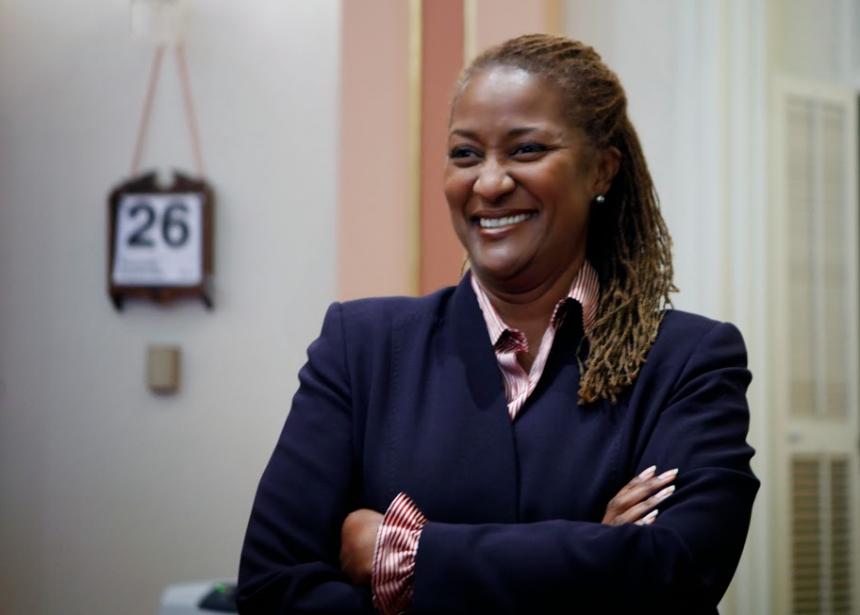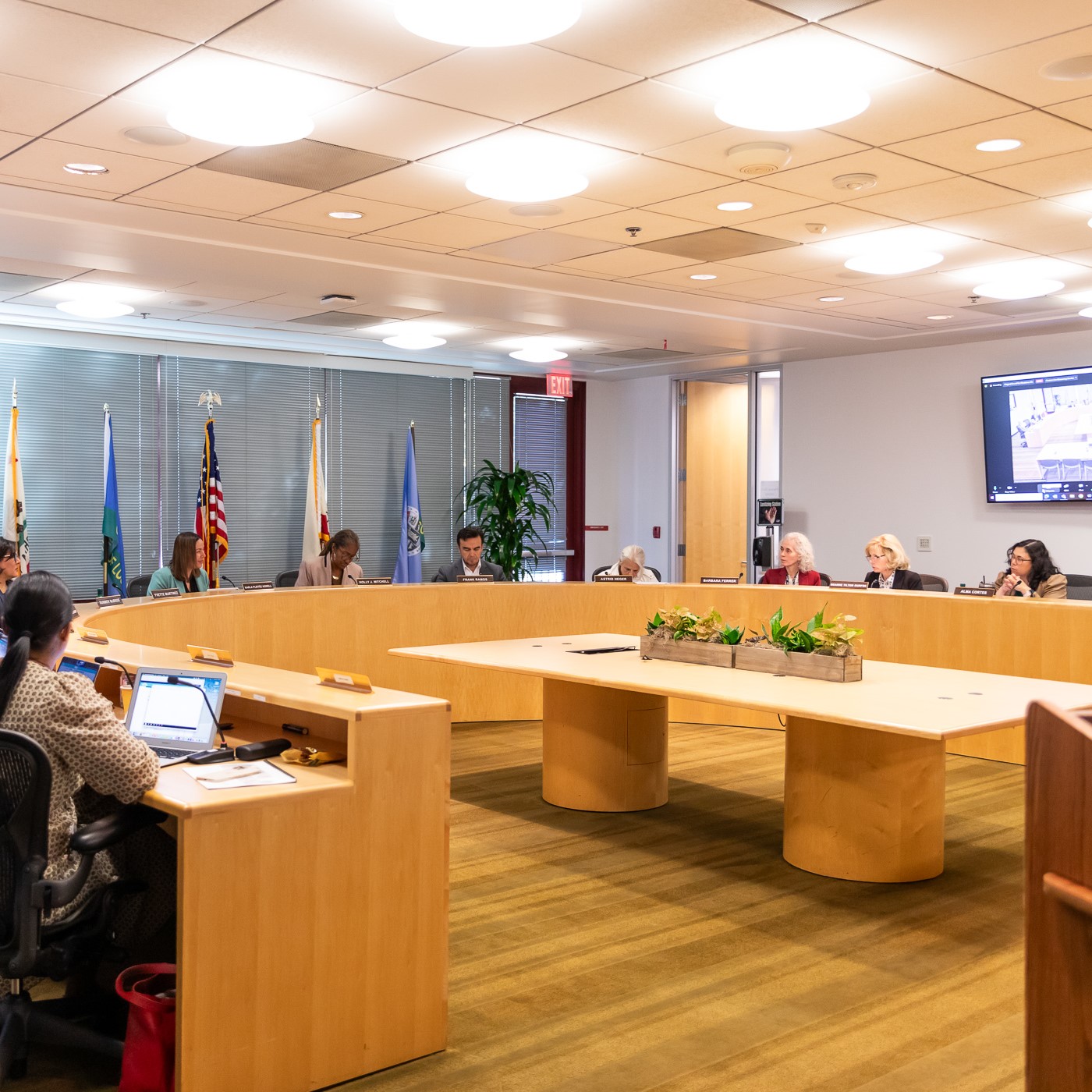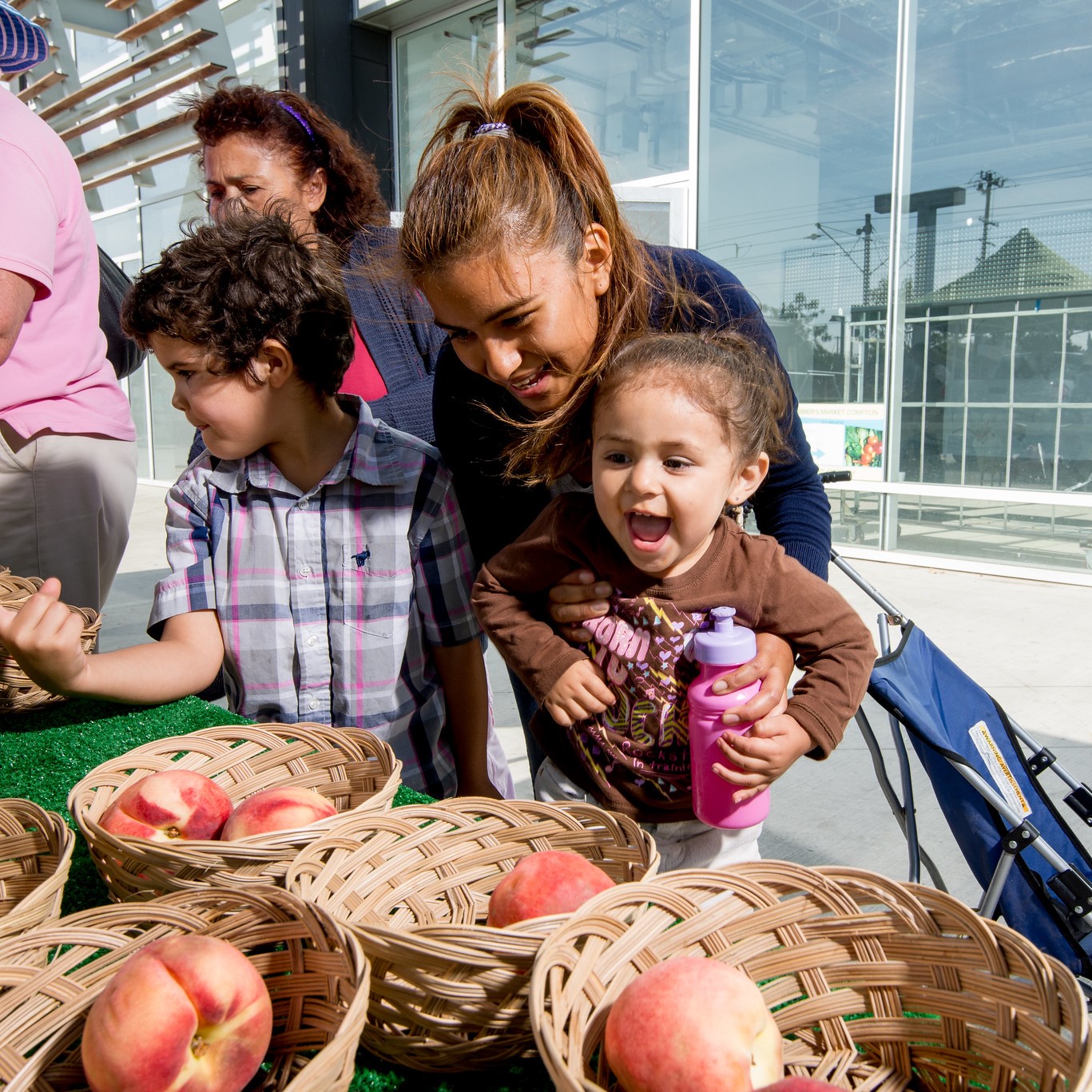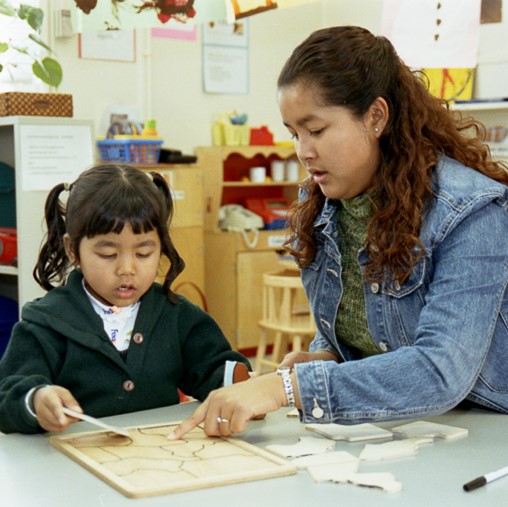September 25, 2018
“Children are about the supports we give them, what we expose them to and how we lift them up to create opportunities for them.” – California State Senator Holly J. Mitchell
They say a person’s vision changes over time. Not so for State Senator Holly J. Mitchell (D-Los Angeles), who has spent her professional career focused on a clear vision: “to create a California where every child has access to all the resources they need to thrive.”
It’s a vision she has followed since her early career while working for the Western Center for Law and Poverty and in her role as chief executive officer of Crystal Stairs, California’s largest child and family development organization. The “massive haircuts,” as she calls them, that took place in early care in education in 2008 prompted her to run for office in 2010, when she won a seat in the Assembly. In 2013, she was elected to the Senate, where she represents nearly 1 million residents of Senate District 30. During her time in the Legislature, Mitchell has had nearly 60 bills signed into law and currently serves as chair of the Senate Budget and Fiscal Review Committee.
Yet with each step up she has climbed in her legislative career, Mitchell’s view of a better landscape for California’s children has stayed grounded in beliefs shaped from her own childhood.
Recently, Mitchell took a break during her busy schedule to share a few insights about the person in her life who most influenced her vision, her legislative milestones on behalf of children, her own experience with early care and education and her “wish list” for the future.
Q. Growing up, who was your champion for children?
A. I’d have to say my mom, Sylvia Johnson. I’m a 3rd-generation native Angeleno. She was a social worker with the L.A. County Department of Public Social Services. I grew up hearing stories and experiencing her giving her all to the kids in her caseload. She loved it. She had a young girl in her caseload whose name was Robin. Robin’s mother was physically abusive and my mom took Robin under her wing. Later, Robin was able to communicate to my mom as an adult about what having her in her life meant to her and how she’s convinced my mother saved her life. I just learned a great deal from my mom in terms of how to affect change, how to not take no for an answer and how to use government and government institutions to support health and protect children.
Q. How else did your mother motivate you to want to help other children?
“Children are about the supports we give them, what we expose them to and how we lift them up to create opportunities for them.” – California State Senator Holly J. Mitchell
A. I witnessed it through her example. She was transferred over to probation in the 1960s and ‘70s when there was an influx of public dollars and any number of innovative creative programs around detention and prevention. She believed in exposing children to unique opportunities, which is kind of the story of my life. I remember going to the beach or to the Greek Theater for concerts in the summer time and how she would take the kids on her caseload and me. Then she decided she was going to take a group of boys and girls to the Links Cotillion, where they present the young men and women from black high society. She bought a table and decided she was going to take these young kids from juvenile hall. They had mentors and got tuxedos and long dresses and had people come in to show them table manners so they would feel comfortable while they were there. These young people who lived right there in the community had never been in the hotel. Some had never been on a floor that high in a hotel before. It was about showing a community that those kids were no different than the children of the doctors and attorneys who were being presented. They had just been exposed to and given different opportunities. That was the lens by which she lived a 40-year career in social work, probation and corrections. And from that, I fundamentally understood that children are about the supports we give them, what we expose them to and how we lift them up to create opportunities for them.
Q. How did working with Crystal Stairs align with your vision?
A. Crystal Stairs was founded by two women who wanted to create the same kind of access to ECE services on the south and east sides of L.A. County as were abundantly available on the north and west sides. I’m cut from that same fabric. Wanting to make sure that all children have what they need to be successful.
Q. How does your vision drive your legislative team?
A. My entire team went through a Strategic Planning process a couple years ago where we talked about why we’re here. We created a real succinct vision statement to ground us in our work as new team members come aboard, so everybody’s clear about why we come to work here every day. I’m working class so I have to work. We all have to work. But we all have a choice of where we work. I want the people to work for me and be on my team to share this common vision: to create a California where every child has access to all the resources they need to thrive. I’m clear that access to high quality affordable accessible culturally relevant early care and education is one piece of the puzzle in creating the capacity and the desire to learn and all the things we pour into young children in a solid, high quality ECE environment. And we do that in order to make sure they have all the resources they need to thrive.
Q. During your work in the Assembly and Senate, what have been your most rewarding milestones on behalf of children?
A. I can look at a number of budget and legislative actions I’ve been engaged in:
1) The elimination of the Maximum Family Grant rule in the CalWORKs program was huge. Economists and policy wonks tell us that the Maximum Family Grant policy that was put in place about 30 years ago was probably one of the primary determinants of increasing the child poverty rate in California. We were successful – after a four-year attempt – in eliminating the Maximum Family Grant in 2016, which put more money in the pockets of CalWORKs families who had additional children while they were already on the caseload. (Editor’s Note — CalWORKs is a state program that provides cash assistance to families who need help with housing, food, utilities and clothing, as well as welfare-to-work programs such as job training and classroom education. Under the Maximum Family Grant rule, California denied financial support to babies born while their families were receiving CalWORKs basic needs grants, endangering the health and wellbeing of infants born into poverty and intentionally limited the reproductive decisions of poor women. Mitchell proposed repealing the Maximum Family Grant rule in Senate Bill 23 in 2014.)
2) In 2008, early care and education, as you well know, took a massive haircut. I was living through that experience at Crystal Stairs. It made me mad enough to run for office. What compelled me to become a candidate was I thought there were people making decisions on cutting the programs that didn’t have the intimate working knowledge like I did of the system. So they were making cuts in less than ideal areas.
So, for example, my first year in the Legislature (in 2011), they wanted to eliminate the CalWORKs subsidy for 13-year-olds. In the budget committee, I asked the (person from the) department of Finance, “Well, why?” (Editor’s Note — CalWORKs provides child care services to children in three stages beginning from birth. Stage 3 includes 13-year-olds.)
Well, first, he said that there weren’t that many 13-year-olds on the caseload. And I thought, “That can’t be right in the one year since I left Crystal Stairs.” In the budget hearing that day were leaders from the various child-development agencies, including Crystal Stairs. I texted them and I asked them to check with their program managers how many 13-year-olds they have on their caseload. They were able to get back to me and I was able to challenge his assertion. It made me think that I couldn’t trust what Finance said. Thank God I was there because I knew better. I was able to stop that process and keep them from cutting the 13-year-olds off. If I had not been at the table, 13-year-olds would have been on the menu.
Q. How do you see your role as Budget Chair in shaping young children’s futures?
A. I am clear with every decision I make as a policy maker. Be it a vote on a bill, a bill I carry, actions I support or champion or as budget chair: it’s all with my eye on the next generation. I think through tough votes about the impact — not just on today, but on the future of California … making sure there are resources available so all children can thrive and be successful. So that’s the lens by which I view my work as budget chair: how are we investing in California and Californians effectively?
Where our Governor has continued to talk about wanting to save for a rainy day, I’m clear that every day in California it’s raining on somebody’s head. And so, while it’s appropriate — as we all must do in our own lives — to save for days when the general fund won’t be so healthy, I can’t do that while people suffer today. So it’s a real balanced approach. So, yes, this year we’ve socked away record levels in rainy day funds, but we also invested again in children.
Q. Please take a moment to comment on the importance of each of these three legislative milestones from 2018:
1. Early Care and Education (ECE) funding
2. CalWORKs Home Visiting Initiative funding
3. CalWORKs grant increases
1. ECE funding:
A. K-12 did very well this year in terms of us fully funding LCFF (the Local Control Funding Formula) a year or two ahead of schedule. The investments we’ve made back in early care and education are significant. The haircut it took in ’08 eliminated about 110,000 child-care slots. With the support of the Women’s Caucus, we’ve worked very hard to hopefully stabilize the industry by providing rate increases to providers, where we wouldn’t have that revolving door scenario where people come and go because they can’t afford to be a child care provider. And we’ve funded slots. We’re not back to the 110,000 we lost, but we’re making progress every budget cycle. (Editor’s Note – The 2018-19 state budget provides for 13,407 new alternative-placement early care and education spaces and 2,947 preschool slots statewide; $40.2 million to increase provider rates for infants, toddlers and special-needs children; and $123.6 million for rate increases for new full-day preschool. See more details here.)
2. Home Visiting Initiative funding:
A. The Home Visiting Initiative is something that was really important and we took a look at it and wanted to make sure it was as useful and helpful to families as possible. I wasn’t interested in instituting a home visiting program where untrained social workers were coming to recipients’ houses and passing judgement. We insisted on making sure that the workers who would be engaged in the process would go through bias training and there wouldn’t be any fear, particularly with what is going on in this country … fear of government intervention. And if a home visiting program is to work, people have to be comfortable with the person coming to bring the support. The fact that the home visitors will be nurses and social workers and the ways in which they can collaborate with CalWORKs workers will really make sure of that. The whole point is that parents are aware of all the services available to them, be it mental health, domestic violence services, whatever the case may be. This includes cash resources. Families can get up to $500 in funding to spend on a newborn. I think it is a program that will do well.
3. CalWORKs Grant Increases:
My challenges weren’t unique to any other working parent out there. – California State Senator Holly J. Mitchell
A. This budget cycle we were able to increase the CalWORKs grant by the largest amount in 30 years, putting more money in the pockets of working families so they can provide for their children. The grants will increase by 10 percent by mid-2019 with an annual ongoing cost of about $360 million a year. And that always gives the governor heartburn when we make these big investments. But when the current grant is less than 40 percent of the federal poverty level, my argument is that this isn’t something we can continue to ignore. We can’t kick this can down the road. The grant level was cut in 2008. So to expect people to live in 2018 on a cash grant that was $9 a month less than what a family of three was getting over 10 years ago, that statistic alone just stopped me in my tracks. Currently, 41 percent of the federal poverty level is $714 for a family of 3. (Editor’s Note — By raising the grant level to at least 50 percent of the federal poverty level, a family of three will receive about $785 by April 2019. The grant increase helps more than 1 million Californians – nearly 900,000 of them children. In February, Senator Mitchell authored Senate Bill 982, which proposed the increase and was adopted into the Legislature’s budget signed by Governor Brown.)
 Q. You have mentioned in the past about your own challenges finding preschool for your then young son. Care to elaborate?
Q. You have mentioned in the past about your own challenges finding preschool for your then young son. Care to elaborate?
A. My challenges weren’t unique to any other working parent out there. When my son was a newborn, I used a resource and referral agency in Sacramento very effectively. They gave me a list I worked off and found wonderful child care. But in my due diligence in visiting places, I saw places that were great, I saw places that didn’t meet the needs of me or my family, and I saw places I wouldn’t leave my child. Again, the system is based on parental choice and so that worked for me.
When I assumed the leadership position at Crystal Stairs, my son was about 18-months-old and we moved to Los Angeles. What was important to me was that he received care in my own service area. So I tapped into and used child care providers in the community in which Crystal Stairs provided services. Throughout his early care and education experience in Los Angeles, then, they were all Crystal Stairs providers. So I was coming in doing my private pay sign-in sheets right next to the green or blue sign-in sheets for subsidy programs. As the leader of the organization, I felt that it was important that if it was good enough for the families that receive care from Crystal Stairs then it needed to be good enough for the leader of the agency.
And so, my search was no different from any working parent. You find somebody whose working out beautifully and things are going well and it’s family day care and something happens. They have a health crisis or a family member dies and they have to leave for a week and you have to figure out what to do next. At a child care center, you’re on the wait list, he gets in and you breathe a sigh of relief. He bonds with a particular teacher and she decides to leave and go to another job. So being a parent of a young child, you’re in a constant state of transition. My experience was no different than any other working family in my state. And all we do is the best that we can with options that are affordable and accessible. Like every other working mother, those are the factors I had to take into consideration.
Q. What is on your “wish list” for young children in California in the future?
A. I go back to my vision statement. My wish is that we live in a state in which every child – regardless of (their) parents’ educational attainment, regardless of race creed or color or immigration status – has access to the resources they need to thrive. That is my mantra. You will hear that woven throughout my committee statements, my floor statements. It informs the work I do on the budget and the work I do legislatively. Specifically, regarding ECE – very similar to my vision statement – the goal would be to have an early care and education system in California where all eligible children’s needs were met. We wouldn’t have a wait list. You told me to dream, so I’m dreaming.







